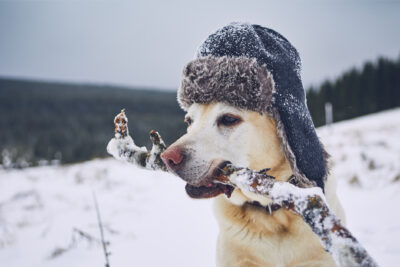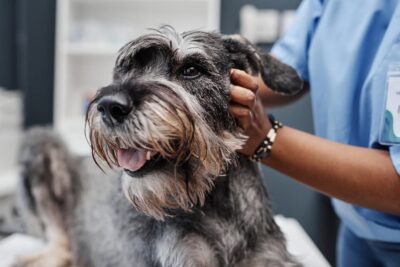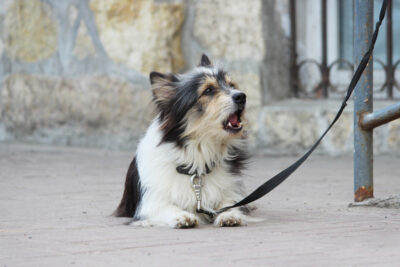7 Signs of Dementia in Dogs

If your senior dog starts acting unusual — getting stuck behind furniture, erratically pacing, or suddenly having accidents in the house — something isn’t right. These behaviors could be signs of dementia in dogs — or, as it’s officially called, cognitive dysfunction syndrome (CDS or CCD).
This disease, which has no cure and shares many similarities with human dementia and Alzheimer’s, is more common than most pet parents realize. Research suggests that about 28 percent of dogs aged 11 or 12 have canine dementia (1). By age 15 or 16, that number climbs to around 70 percent. In some cases, symptoms can appear in dogs as young as 6 to 8 (2) — but both pet parents and veterinarians can overlook the signs, especially subtle ones.
“Age is definitely one of the risk factors,” says Dr. Katrin Jahn, a behavioral veterinarian at the German Veterinary Clinic in Abu Dhabi, UAE. “We think about dogs from the age of around 8 showing signs of this, and then as they get older, the numbers rise quite dramatically.”
7 Signs of Dementia in Dogs
Dr. Jahn, a practicing veterinarian for more than 25 years, explains that symptoms of canine dementia can vary widely from dog to dog. To help identify the condition, she says that veterinarians now use a framework known as DISHAAL. This acronym stands for:
- Disorientation
- Interaction changes
- Sleep-wake cycle disturbances
- House-soiling
- Altered activity levels
- Anxiety
- Learning and memory changes
So, how do pet parents recognize these doggy dementia signs? Here’s a closer look:
Disorientation
Disorientation can show up in many different ways in dogs. Your pet might get stuck trying to navigate around furniture, struggle to walk through doorways, or even seem lost in their own backyard. Pet parents might also observe their dogs staring blankly.
“We’ll often see dogs that are staring off into space,” Dr. Jahn says. “Sometimes they’ll get lost behind a door, they’ll go into a corner, and they find it difficult to find their way back out again. So, that kind of spatial awareness is challenged.”
Other signs of disorientation can include heightened reactivity to sights or sounds. Also, dogs with dementia may not appear to recognize familiar people or fellow pets.
Changes in social interactions
For pets with dementia, social interactions can become suddenly difficult or unpredictable. Some dogs may become more irritable, anxious, or even aggressive toward visitors or other animals. Others may withdraw, showing less interest in petting or affection.
“We can get alterations in interactions with people and interactions with other pets in the home,” Dr. Jahn says. “Sometimes those interactions can be elevated, so the dogs are a little bit more kind of clingy. Sometimes they can deteriorate or decline, so we’ll have less interaction.”
In other cases, there might be a physical reason for your dog’s behavior change. Dr. Jahn explains that dogs with CDS may experience chronic pain, sensory decline, or gastrointestinal issues, which may cause physical discomfort. And as a result of this discomfort, your dog may feel more irritable or even act a little aggressively at times.
Sleep-wake cycle disturbances
Dogs with dementia may experience disruptions in their sleep patterns, which can lead to nighttime waking, restlessness, or pacing.
“This is common, and I think that’s also something we see in humans as well,” Dr. Jahn says. “All of a sudden, there are different sleep patterns throughout the day and waking at night.”
In some cases, pain is to blame for this restlessness. “We know that pain is perceived differently at night than it is during the day,” says Dr. Jahn, noting that this can contribute to increased pacing or agitation after dark.
Another frequent symptom is nighttime vocalization, with some dogs whining, barking, or howling throughout the night.
House-soiling
Another sign of doggy dementia is house-soiling, even if your dog is well house-trained.
“A dog that would normally know to ask to go out to the toilet might lose that learning piece,” Dr. Jahn says.
Change in activity levels
Another sign of dementia in dogs is changes in activity levels — and these changes can go in either direction. Some dogs may lose interest in activities they once loved, while others may develop new, repetitive behaviors, such as pacing, licking, or circling.
“Sometimes they get really restless and they pace, so we get an increase in activity,” Dr. Jahn says. “But sometimes we get decreased activity — so a lot more sleeping, maybe they’re less active, less playful.”
Anxiety
Increased anxiety is another common symptom, particularly when dogs are separated from their pet parents for any period of time.
“Owners will sometimes describe their dogs as being more clingy or more needy, or just being their shadows — glued to them more,” Dr. Jahn says.
Dogs with dementia may also become more sensitive and reactive to sights and sounds, and can develop a heightened fear of unfamiliar environments.
Learning and memory changes
Dogs with dementia often experience changes in learning and memory. For instance, they may struggle to learn new tasks and also forget commands or routines they once knew well.
“We might have loss in learning, loss in cognitive abilities, and poor puzzle-solving abilities,” Dr. Jahn says.
Ways to Manage Dog Dementia Signs
While pet parents can try and look for signs of canine dementia themselves, Dr. Jahn says it is crucial to get a formal diagnosis from an expert.
“Getting that diagnosis is really important,” Dr. Jahn says. “No, we can’t cure the disease, but there’s so much that can be done to support them, make them more comfortable and help slow down that process of neurodegeneration. So, the sooner we can get a diagnosis, the sooner we can actually intervene.”
One of the most important things you can do to help a dog with dementia, according to Dr. Jahn, is to keep their mind active and engaged. Mental stimulation — such as puzzle toys or gentle training sessions — can help slow cognitive decline.
“It’s that whole idea of ‘use it or lose it,’” Dr. Jahn says.
You can also make simple adjustments around the home to better support your dog. For instance, if they frequently get stuck behind doors, Dr. Jahn recommends keeping certain doors open, or closing off certain areas of your home to prevent confusion. It’s also important to ensure they have easy, unobstructed access to their favorite resting spots.
Another thing pet parents can do is create a calm environment that enables your dog to rest as much as possible.
“I think a calm environment is important for any dog, and as our dogs get older, sleep becomes even more crucial,” Dr. Jahn says. To help your dog get the rest they need, she recommends ensuring they have easy access to their bed and a quiet space where they won’t be disturbed while sleeping.
Supplements can be another helpful tool. Dr. Jahn points to products like Senilife, which contain a blend of antioxidants designed to “counteract some of those oxidative processes in the brain” linked to cognitive decline. There are also specially formulated dog foods that incorporate similar brain-supporting ingredients, such as the Purina Pro Plan Neurocare food.
There is also dog dementia medicine that can help your pet. One example, Dr. Jahn says, is selegiline, a psychopharmaceutical that “increases the level or the amount of neurotransmitters available in the brain,” which can help support cognitive function.
Dogs and Dementia: Other Tips and Advice
While medications and supplements can help, Dr. Jahn says the most important step pet parents can take is to make thoughtful adjustments at home to better support a dog with dementia.
“Management at home is massive because it has such a big impact on everyday lifestyle and quality of life,” she says. “So that would probably be my number one thing. And then, of course, you’d come in with the medications, the diets, and the supplements — that would be my number two big thing.”
Dr. Jahn also recommends using calming pheromones to help soothe dogs experiencing anxiety or confusion. This can also help calm a dog with dementia at night. “That would be something I would definitely reach for,” she says.
References
- MacQuiddy, Brittany et al. “Assessment of risk factors in dogs with presumptive advanced canine cognitive dysfunction.” Frontiers in veterinary science vol. 9 958488. 18 Oct. 2022, doi:10.3389/fvets.2022.958488
- Wen, Jun et al. “Canine cognitive dysfunction syndrome and pet tourism.” Annals of Tourism Research Empirical Insights vol 4, issue 2. 2023. doi.org/10.1016/j.annale.2023.100109.









